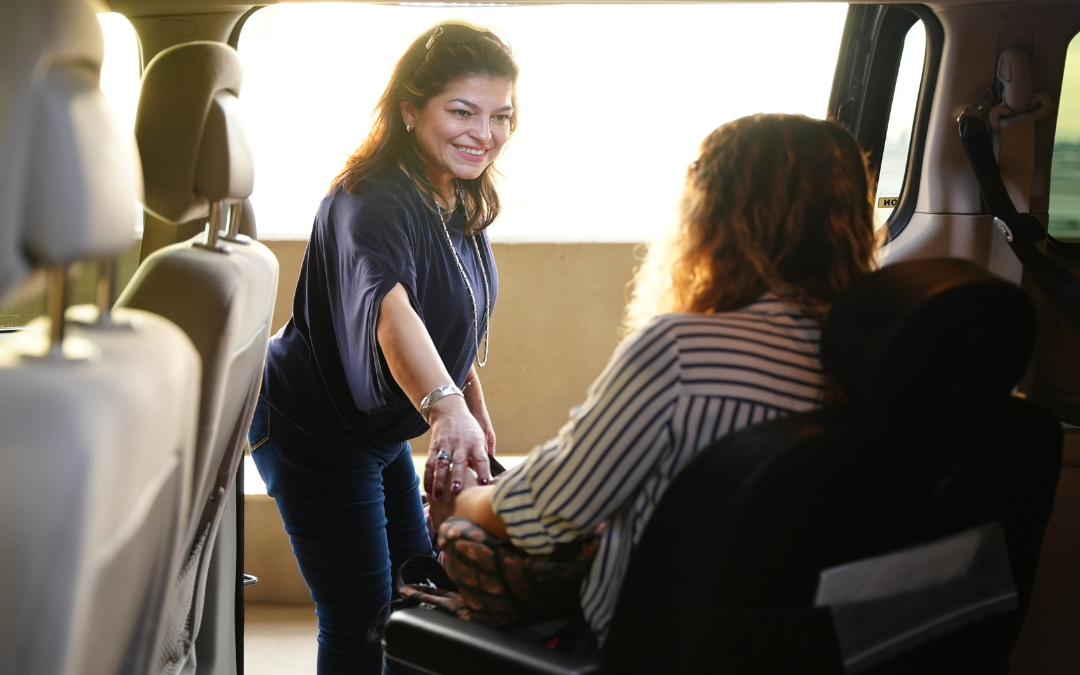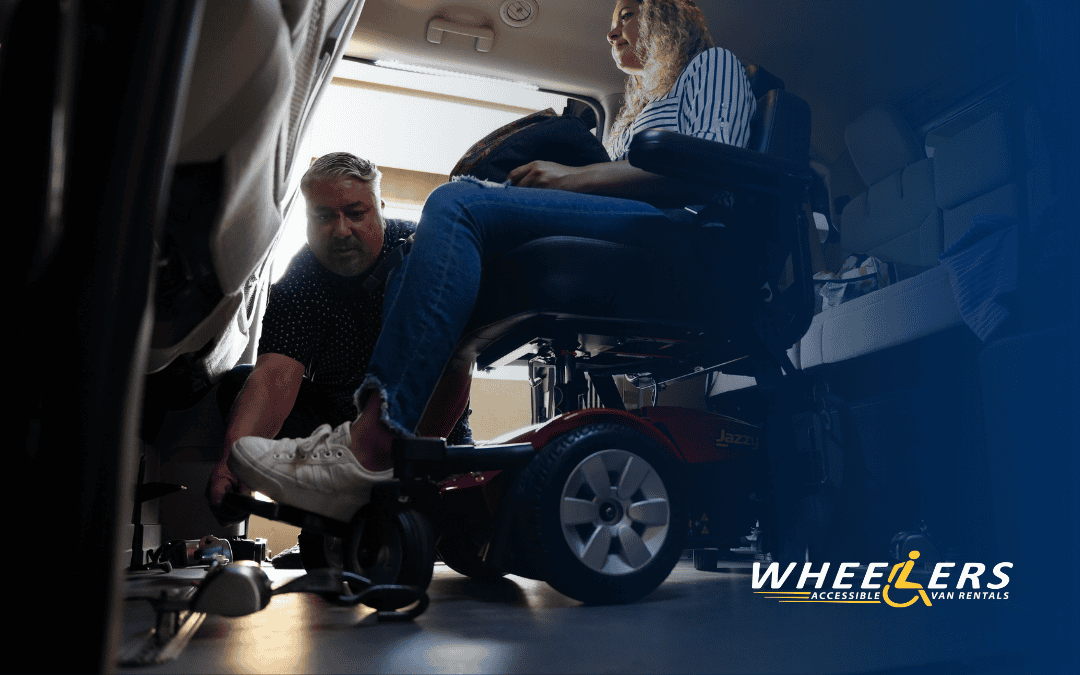Safety on the road starts with proper wheelchair securement. Whether you’re planning a family vacation or heading to medical appointments, knowing how to correctly tie down a wheelchair in your accessible van rental creates peace of mind for everyone on board.
At Wheelers Accessible Van Rentals, we’ve guided countless travelers through this essential process. Our vans come equipped with ADA-compliant securement systems designed to provide both safety and comfort throughout your journey.
Even experienced travelers can benefit from a refresher on best practices. In this guide, we’ll walk you through the entire process of properly securing a wheelchair in an accessible van—from initial positioning to final safety checks—using straightforward, practical advice.
Join us as we share the expertise we’ve developed over years of helping people navigate the open road with confidence. These step-by-step instructions will ensure you’re ready to travel safely in your Wheelers accessible van rental.
Understanding Wheelchair Securement Systems in Rental Vans
Ever wondered what all those straps and anchors in your accessible van are actually for? Let’s break down the essentials of wheelchair securement systems – the hardware that keeps everything stable while you’re cruising down the highway or navigating city streets.
Common Securement Methods
Manual Tie-Down Straps
Most Wheelers vans come equipped with the tried-and-true four-point tie-down system. Think of it as the seatbelt equivalent for wheelchairs – four adjustable straps that connect from the floor anchors to solid parts of the wheelchair frame. These workhorses handle everything from lightweight travel chairs to heavy power wheelchairs with equal effectiveness.
Want to see exactly how it works? We’ve put together a helpful video demonstration that walks you through the process step by step.
Retractable Systems
In some of our newer vans, you’ll find retractable tie-down systems that neatly tuck away when not in use. No more straps draped across the floor or tangled under seats – these systems stay out of sight until you need them.
Safety Standards for Wheelchair Accessible Vans
Every securement system in our fleet meets rigorous safety standards. We don’t just meet the minimum ADA requirements – we make sure our equipment is regularly tested and maintained to deliver peace of mind with every mile.
Step-by-Step Guide: How to Tie Down a Wheelchair in an Accessible Van
Ready to hit the road safely? We’ve broken down the wheelchair tie-down process into simple steps that anyone can follow. Check out our video walkthrough for a visual guide that shows these techniques in action:
Positioning the Wheelchair Correctly
Getting the position right from the start saves you time and hassle later. Roll the wheelchair into the designated securement area, making sure it’s centered and facing forward – just like a regular vehicle seat. This positioning ensures the securement system works as designed and provides maximum protection.
Before you start attaching any straps, don’t forget to engage the brakes on the wheelchair. This simple step prevents the chair from rolling during the securement process and helps you get a tighter, more secure fit with the tie-downs.
Attaching the Securement Straps
Look for the four tie-down anchor points in your Wheelers van – they’re typically marked with clear indicators on the floor. These sturdy floor anchors are specifically designed to withstand force during travel.
Connect the front and rear straps to solid, non-moving parts of the wheelchair frame – never to wheels, armrests, or any detachable components. The strongest connection points are usually on the main frame close to where the wheels attach. If you’re not sure about the best attachment points for your specific wheelchair model, just give us a call!
For vans equipped with automatic docking systems, simply align the wheelchair with the docking station until you hear the satisfying click of a secure connection. These systems take much of the guesswork out of proper securement.
Tightening the Straps for Stability
Think of strap tightening like Goldilocks – not too loose, not too tight, but just right. Adjust each strap so there’s no obvious slack, but avoid cranking them down with excessive force. The wheelchair should feel firmly anchored but not under strain.
Once all straps are attached and tightened, give the wheelchair a gentle push from different angles. If it shifts more than an inch in any direction, you’ll need to readjust your straps for a more secure fit.
Using a Seatbelt for Added Safety
The tie-down system secures the wheelchair, but the passenger needs protection too! Attach the lap belt low across the passenger’s pelvis (not over the stomach) for the best crash protection.
Position the shoulder belt so it crosses the middle of the chest and rests on the shoulder comfortably – never against the neck or face. A properly positioned seatbelt works just like it does in a standard vehicle seat, providing crucial protection during sudden stops or accidents.
Common Mistakes to Avoid When Securing a Wheelchair
Even experienced travelers occasionally make mistakes when securing wheelchairs. Here are some common pitfalls to watch out for:
Forgetting to Engage the Brakes
It might seem obvious, but it’s surprisingly easy to overlook engaging the wheelchair’s brakes before beginning the tie-down process. Without the brakes engaged, the chair can shift during securement, resulting in loose straps that won’t provide adequate protection during travel. Make this your very first step every time—it only takes a second but makes a significant difference in security.
Attaching Straps to Weak or Movable Parts
Not all parts of a wheelchair are created equal when it comes to tie-down points. Avoid attaching straps to:
- Removable armrests
- Footrests or leg supports
- Wheels or spokes
- Height-adjustable components
Instead, look for solid frame components that won’t bend, break, or detach under pressure.
Improper Strap Tension
Finding the right balance with strap tension takes a bit of practice. Straps that are too loose allow dangerous movement during transit, while over-tightened straps can put stress on the wheelchair frame or make it difficult to release the securement when you reach your destination.
A good rule of thumb: you should be able to fit one finger under the strap when properly tightened. This provides enough security without excessive pressure. And remember to check tension on all four straps—they should have roughly equal tightness for balanced securement.
Skipping the Occupant Restraint
The wheelchair tie-down system and the occupant restraint system (seatbelt) work together as a complete safety package. One without the other leaves protection incomplete. Always make sure both the wheelchair and its occupant are properly secured before starting your journey.

Extra Safety Tips for a Smooth Ride
Getting the basics right is essential, but these additional tips will help ensure every journey is as safe and comfortable as possible:
Perform a Pre-Drive Safety Check
Before putting the key in the ignition, take a moment to double-check your securement setup. Gently push and pull on the wheelchair from different angles to confirm it’s firmly anchored. This quick check can catch potential issues before they become problems on the road.
Power Down Electric Wheelchairs
For power wheelchairs, switch off the power before securing. This prevents accidental joystick movements during the tie-down process and eliminates any risk of the chair trying to move against the restraints while driving.
Consider Weather and Road Conditions
If you’re heading into rough terrain or expect challenging weather, take extra care with your securement. You might want to check and readjust your tie-downs more frequently during stops if you’re traveling on bumpy roads or through stormy conditions.
Practice Makes Perfect
If you’re new to wheelchair securement, consider practicing the process a few times before your actual trip. Becoming familiar with the system in a low-pressure situation makes it much easier when you’re eager to get on the road.
Ask for Help When You Need It
At Wheelers, we’re always just a phone call away if you have questions about securing a specific wheelchair model. Don’t hesitate to reach out to our team for guidance—we’d much rather answer your questions than have you worry about getting it right.
Travel Confidently with Wheelers Van Rentals
Properly securing a wheelchair in your accessible van isn’t just about following regulations—it’s about creating peace of mind for everyone on board. When you know your securement is solid, you can focus on enjoying the journey and making memories along the way.
Whether you’re planning a weekend getaway or need reliable transportation for daily activities, Wheelers Van Rentals provides the equipment and support you need for safe, comfortable travel. Our fleet of wheelchair-accessible vans combines convenience with security, giving you the freedom to explore on your own terms.
Ready to experience the independence of accessible travel? Our team is standing by to help you select the perfect van for your needs and ensure you feel confident about every aspect of your rental—including proper wheelchair securement.
Plan your accessible road trip today! Reserve your van with Wheelers Accessibly Van Rentals and discover how easy independent travel can be. Click here to see the locations we rent wheelchair vans in.

